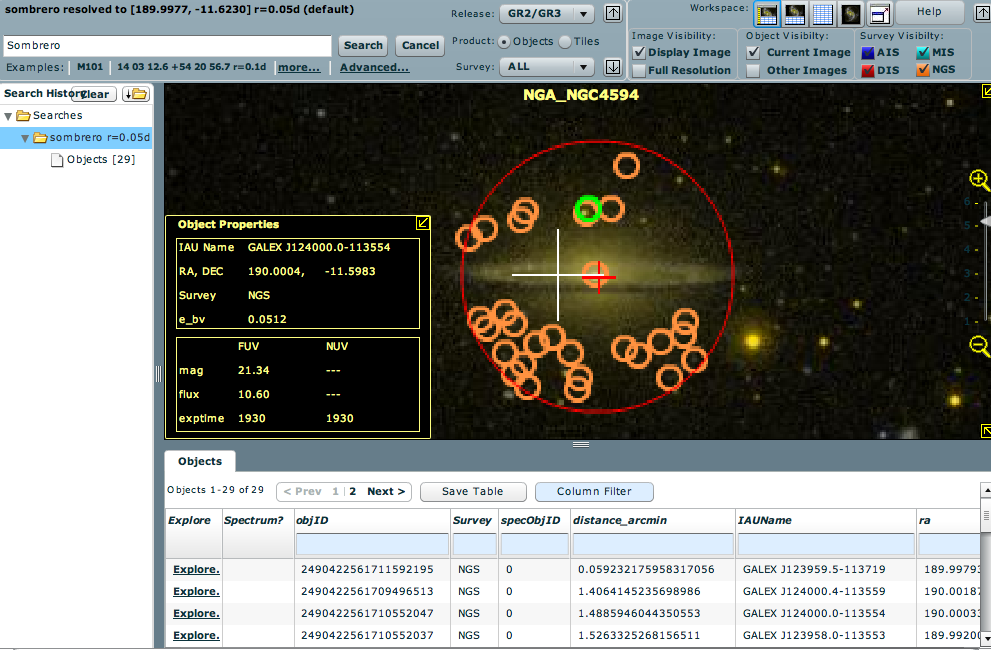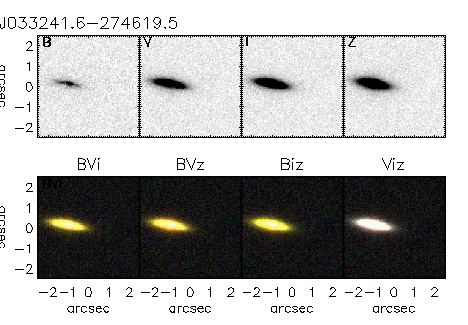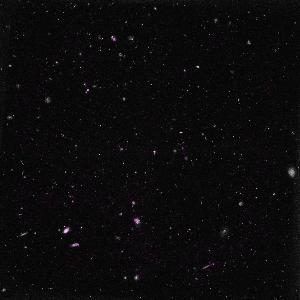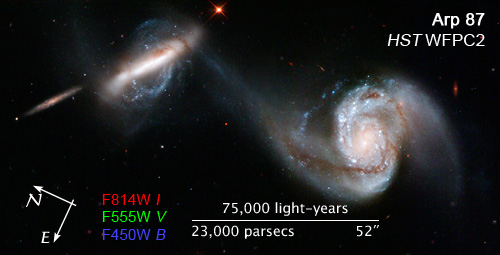|
|||||||||||||||||||
|
|
|||||||||||||||||||
The Multimission Archive at STScI Newsletter
| August 6, 2008 | Space Telescope Science Institute | Volume 21 |
| The Multimission Archive at STScI (MAST) Newsletter disseminates information to users of the HST, FUSE, GALEX, IUE, Copernicus, EUVE, HUT, UIT, WUPPE, HPOL, IMAPS, BEFS, TUES, VLA-FIRST, and XMM-OM data archives supported by MAST. Inquiries should be sent to archive@stsci.edu. |
Table of Contents

|
PyDrizzled Images for WFPC2
Users requesting WFPC2 data from the MAST archive now receive an additional data product, a quick-look mosaic of the images from all four detectors. The new files, labeled *drz.fits, are produced by the program PyDrizzle, which was recently incorporated into the WFPC2 calibration pipeline. PyDrizzle uses the WFPC2 distortion corrections recently derived by Luigi Bedin. Output images have a plate scale of 0.1" per pixel. Because PyDrizzle is run on each WFPC2 exposure independently, it cannot perform sub-pixel sampling or cosmic-ray rejection. The DRZ files are provided in standard (multi-extension) FITS format, rather than the waivered FITS (GEIS) format used by the other WFPC2 files. The primary extension contains only header information; the first extension contains the drizzled image. A Space Telescope Analysis Newsletter (STAN) describing the DRZ files will be issued later this month. An Instrument Science Report (ISR) describing the new geometric distortion corrections will be issued in a few months. Because they lack cosmic-ray rejection, DRZ files are intended as quick-look images, rather than as science data products.
Over the next several months we will be reprocessing all of the WFPC2 data, using the best calibrations available, and archiving the fully calibrated datasets in both GEIS and FITS formats. More information will follow in the next newsletter.
GALEX Release 4 (GR4) imaging completed
The completed AIS (all sky) survey has been delivered and staged on the MAST GALEX website, thereby completing the imaging component of the GR4. Grism data is being ingested at this writing, and at 143 tiles will almost triple the MAST holdings of GALEXZ spectra. The GR4 imaging dataset is huge (11.6 TB, including its database of 1TB) and covers some 31,000 tiles (almost the same number of square degrees on the sky). The GR4 delivery completes what the GALEX project terms its "primary mission."
Users now have a choice to go to the old GR2/GR3 pages or to the new GR4 website. The default homepage will be switched shortly when images are created for the Map tool, which will also point to one or the other GR datasets.
The new galexView data search/discovery tool.
The MAST GALEX team is pleased to announce the inauguration
of the "galexView" web application.
The galexView tool easily accommodates searches for tiles or objects.
By using the new Adobe Flex
technology, galexView gives the user the instantaneous "desktop feel" once the
data are loaded. We have just rolled out version 1.2, and a snapshot
is shown in the figure below.
 The galexView browser page may be
divided into up to 3 separate panes that show the image for the tile the
user has selected, a table giving information about each of the objects,
and a search history, such that one can readily return to previous visits.
Version 1.2 also provides an upload target list facility that allows
one to collect search results for a large number of targets, specified
by coordinates. Catalogued objects in the tile (or neighboring tiles) may
be switched on, color coded by survey. The snapshot shows an example of a
search on the GR4 dataset for the Sombrero galaxy. The orange circles in
the snap are the objects from the Nearby Galaxy Survey returned from the
request out to a designated search radius (red circle). A specific object
may be 'clicked on', turning its circle green and bringing up an Objects
Properties box, as shown in the snap to the lower left of the image.
We are currently developing a new generation of this tool and also
investigating ways to modify the Map tool (see
article in the February 2008 newsletter) to
exploit the best of its native Mapserver technology as well as the
capabilities of Flex.
The galexView browser page may be
divided into up to 3 separate panes that show the image for the tile the
user has selected, a table giving information about each of the objects,
and a search history, such that one can readily return to previous visits.
Version 1.2 also provides an upload target list facility that allows
one to collect search results for a large number of targets, specified
by coordinates. Catalogued objects in the tile (or neighboring tiles) may
be switched on, color coded by survey. The snapshot shows an example of a
search on the GR4 dataset for the Sombrero galaxy. The orange circles in
the snap are the objects from the Nearby Galaxy Survey returned from the
request out to a designated search radius (red circle). A specific object
may be 'clicked on', turning its circle green and bringing up an Objects
Properties box, as shown in the snap to the lower left of the image.
We are currently developing a new generation of this tool and also
investigating ways to modify the Map tool (see
article in the February 2008 newsletter) to
exploit the best of its native Mapserver technology as well as the
capabilities of Flex.
MAST Forum
MAST has established the "MAST Forum" in response to suggestions from our user community. You can find a link to the Forum on the second line of the top navigation bar of most MAST web pages. It should be the right most link on each page.
The forum is a place for MAST users to post topics related to the MAST archive, either suggestions or questions on using MAST tools and services are welcome. Recently we have been considering changes to the MAST website to improve navigation. We have posted a topic related to this in the forum and are looking forward to seeing a discussion on this topic by our users. To avoid spam postings, you will need to register on the forum to post.
Community-contributed High Level Science Products
GOODS - Version 2.0
|
The GOODS team released Version 2.0 of the data and catalogs in May 2008.
Version v2.0 is a significant improvement upon the previous v1.0 release. The v1.0 data release provided data acquired as part of the original GOODS HST/ACS program (HST Cycle 11, program IDs
9425 and
9583).
Version 2.0 augments this with additional data acquired on the two GOODS fields during the search for high redshift Type Ia supernovae carried out during Cycles 12 and 13 (Program ID
9727, P.I. Saul Perlmutter, and
9728,
10339, and
10340, P.I. Adam Riess).
In addition to the data, a new version of the GOODS cutout tool is also available. The cutout tool allows users to create a cutout image (in FITS format) from the GOODS data sets based on a target name or coordinates and a width in arcseconds. Several qualifiers can be used to create image cutouts. The tool can be used from either the HTML search form, or as a Web service following the Virtual Observatory (VO) Simple Image Access Protocol (SIAP) cutout protocol |

Sample of the preview images from the GOODS cutout tool |
Coma Cluster Treasury
|
The HST ACS Coma cluster Treasury survey is a deep two-passband imaging survey of one of the nearest rich clusters of galaxies, the Coma cluster (Abell 1656).
The PI of this program (HST Proposal number 10861) is David Carter.
The survey was designed to cover an area of 740 square arcmin in regions of different density of both galaxies and intergalactic medium within the cluster. The ACS failure of January 27th 2007 leaves the survey 28% complete, with 21 ACS pointings (230 square arcmin) complete, and partial data for a further 4 pointings (44 square arcmin). |
STIS Next Generation Spectral Library
| The STIS Next Generation Spectral Library (NGSL) contains STIS spectra of 370 stars observed in HST programs 9088, 9786, and 10222. The Library was produced as part of the archival research program, 'Constraining Both the Star-Formation History and Metal-Enrichment History of Galaxies' (AR10659) and was provided by Don Lindler and Sara Heap. Each spectrum includes spectral segments from gratings G230LB, G430L, and G750L merged to form a single spectrum covering ~0.2-1.0µ. NGSL spectra were constructed via custom pipeline processing followed by corrections for in-order scatter by grating G230LB and corrections for throughput variations caused by the mis-centering of the target in the 0.2 arcsecond-wide slit. |

Preview plot of BD+11 2998
|
UV images of the UDF and HDF fields
| Wavelength coverage of the Hubble Ultra Deep Field (HUDF) has been been extended with deep ultraviolet wavelength observations. Observations acquired with the ACS-SBC in the Far-UV {1500 Angstrom} and WFPC2 in the Near-UV {F300W} during excution of the HST Treasury program 10403 ( PI Harry Teplitz -- California Institute of Technology) complete the coverage. Included with this set of data are ACS/SBC observati ons of the Hubble Deep Field North. |

Ultra Deep Field FUV data purple over white/black B-band image.
|
Merging Galaxies
|
In association with the press release of merging galaxies for the HST 18th anniversary, three objects
(ARP 87, NGC 6050 and ARP 148) were made available as
High-Level Science Products.
As with most MAST hosted HLSP, you may see a list at the web site and download the data through your browser or retrieve the data via anonymous ftp. ftp archive.stsci.edu |

|
To Subscribe or Unsubscribe to the Newsletter
If you would like remove yourself from the mailing list send mail to archive_news-request@stsci.edu and put the single word unsubscribe in the BODY of the message. Information on the subject line will be ignored.If you would like to subscribe to the mailing list to receive notification of future Archive Newsletters, send mail to archive_news-request@stsci.edu and put the single word subscribe in the BODY of the message. Information on the subject line will be ignored. You will be asked to confirm the subscription.
|
|
|




 Follow Us
Follow Us